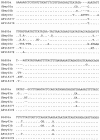Seasonal shedding of multiple Cryptosporidium genotypes in California ground squirrels (Spermophilus beecheyi)
- PMID: 15528541
- PMCID: PMC525134
- DOI: 10.1128/AEM.70.11.6748-6752.2004
Seasonal shedding of multiple Cryptosporidium genotypes in California ground squirrels (Spermophilus beecheyi)
Abstract
Twelve percent of 853 California ground squirrels (Spermophilus beecheyi) from six different geographic locations in Kern County, Calif., were found to be shedding on average 44,482 oocysts g of feces(-1). The mean annual environmental loading rate of Cryptosporidium oocysts was 57,882 oocysts squirrel(-1) day(-1), with seasonal patterns of fecal shedding ranging from <10,000 oocysts squirrel(-1) day(-1) in fall, winter, and spring to levels of 2 x 10(5) oocysts squirrel(-1) day(-1) in summer. Juveniles were about twice as likely as adult squirrels to be infected and shed higher concentrations of oocysts than adults did, with particularly high levels of infection and shedding being found among juvenile male squirrels. Based on DNA sequencing of a portion of the 18S small-subunit rRNA gene, there existed three genotypes of Cryptosporidium species in these populations of squirrels (Sbey03a, Sbey03b, and Sbey03c; accession numbers AY462231 to AY462233, respectively). These unique DNA sequences were most closely related (96 to 97% homology) to porcine C. parvum (AF115377) and C. wrairi (AF115378). Inoculating BALB/c neonatal mice with up to 10,000 Sbey03b or Sbey03c fresh oocysts from different infected hosts did not produce detectable levels of infection, suggesting that this common genotype shed by California ground squirrels is not infectious for mice and may constitute a new species of Cryptosporidium.
Figures




References
-
- Arrowood, M. J., and C. R. Sterling. 1987. Isolation of Cryptosporidium oocysts and sporozoites using discontinuous sucrose and isopycnic Percoll gradients. J. Parasitol. 73:314-319. - PubMed
-
- Atwill, E. R., E. Johnson, D. J. Klingborg, G. M. Veserat, G. Markegard, W. A. Jensen, D. W. Pratt, R. E. Delmas, H. A. George, L. C. Forero, R. L. Phillips, S. J. Barry, N. K. McDougald, R. R. Gildersleeve, and W. E. Frost. 1998. Age, geographic, and temporal distribution of fecal shedding of Cryptosporidium parvum oocysts in cow-calf herds. Am. J. Vet. Res. 60:420-425. - PubMed
-
- Atwill, E. R., E. Johnson, and M. Das Graças C. Pereira. 1999. Herd composition, stocking rate, and calving duration associated with fecal shedding of Cryptosporidium parvum oocysts in beef cattle herds. J. Am. Vet. Med. Assoc. 215:1833-1838. - PubMed
-
- Atwill, E. R., S. Maldonado Camargo, R. Phillips, L. H. Alonso, K. W. Tate, W. A. Jensen, J. Bennet, S. Little, and T. P. Salmon. 2001. Quantitative shedding of two genotypes of Cryptosporidium parvum in California ground squirrels (Spermophilus beecheyi). Appl. Environ. Microbiol. 67:2840-2843. - PMC - PubMed
Publication types
MeSH terms
Associated data
- Actions
- Actions
- Actions
LinkOut - more resources
Full Text Sources
Medical
Molecular Biology Databases

